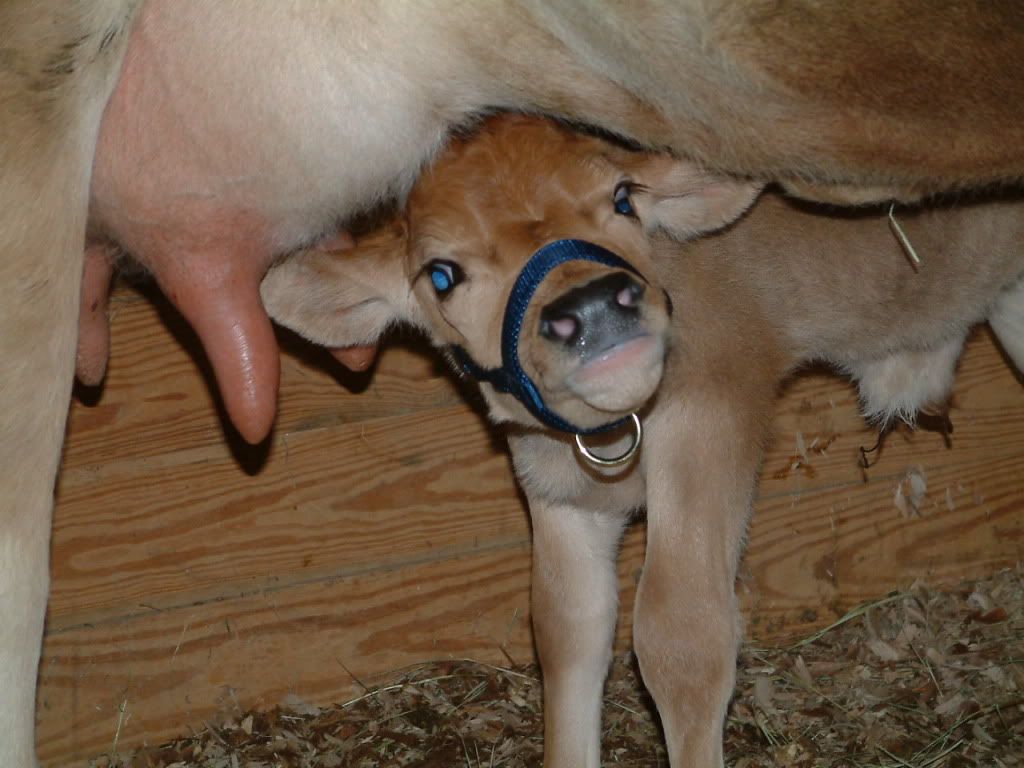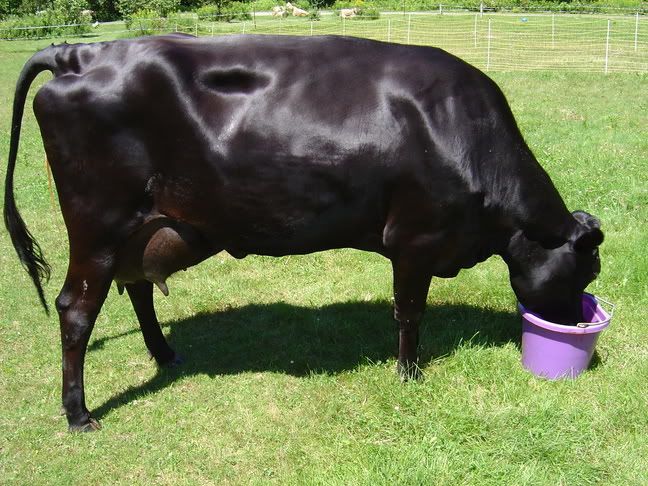Post by briarrose on Dec 29, 2010 4:13:05 GMT -5
I had some concerns so decided to spend my day making phone calls.
Found a gentleman out of northern Oregon that is a dairy nutritionist. He contracts out and helps dairy folk with their nutritional needs. These are the questions I asked him and his answers to me in layman terms.
Is the copper content in my lick tub going to cause copper toxicity in my jerseys? It is 235ppm per 250 lb tub, where the copper in my 40lb bag of loose minerals is 250ppm?
First off the tub has an overeating inhibitor in it. Meaning each cow will only eat a maximum of around 1 lb per day. my jersey would have to consume at least 6 lbs per day to come down with CT from it. On the other hand, they could eat all the loose minerals they want because there is not such an inhibitor in it. He said I might want to reconsider free feeding the loose minerals. ( I have stopped feeding the loose minerals all together at this point.) He also spent some time explaining the research that Sandy had posted about without any prompting from me.
I then explained my full situation with him and explained how I had never had this ketosis problem until I quit using the lick tubs. He asked if I had been raised around dairy cattle and I said yes and so was my father. He then asked what did I remember the most about helping with the cows when I was young. I remember having to mix the molasses and the grain together because my dad had to do it as a boy and hated it so it was now my turn.
About now is when the light went on in my head, and this is what he told me...
Molasses is sugar, or carbs. A cow needs carbs to keep their energy levels up , keeping warm, producing milk, eating and just plain moving around. Sugar is a ready and quick source of carbs. Back in my fathers day they produced their own grain and mixed it with molasses. Bulk raw feed is and was cheaper dry. Back then you bought real molasses pretty cheaply and in bulk, so the milk cows always got "wet" feed. So, I was feeding dry feed and took away their lick tubs. He said I was very lucky that I didn't loose more than one cow. Next he explained the basic cause of ketosis so I could understand it.
The easiest way for a cow to get fast use of carbs is through the sugar in their system. If the sugar is lacking and the cow is not getting enough carbs out of their regular feed for the livers needs then the liver will start processing the cows excess body fat. When that happens the liver throws off extra ketone's. The more body fat that the liver process the worse the ketosis gets. This explains why Rena's drench works so well at bringing them back around. But once you stop giving it unless there is another good source of carbs coming in, the cow will sometimes backslide because the ready to process supply of sugar carbs are already used up.
His cows are what he called pasture cows. He has really nice pasture. The only time he gives them grain is for 3 weeks before calving and for 6 weeks after calving then slowly weans them off the grain. He only feeds "wet" grain and has no ketosis problems. He does supply them with the big round bales of grass hay from time to time and his are fat and sassy, and healthy.
After speaking with him at length I am going back to my old ways. His comment was, "If it's not broke, stop trying to fix it" He was also kind enough to point out that if I had not been trying to pinch pennies where the care of my cows was concerned my Lucy would probably still be alive. That is a guilt I will just have to live with.
Hind sight is definitely 20/20.
Kristy
PS ROR, if you read this thread, I found the spell check button!
Found a gentleman out of northern Oregon that is a dairy nutritionist. He contracts out and helps dairy folk with their nutritional needs. These are the questions I asked him and his answers to me in layman terms.
Is the copper content in my lick tub going to cause copper toxicity in my jerseys? It is 235ppm per 250 lb tub, where the copper in my 40lb bag of loose minerals is 250ppm?
First off the tub has an overeating inhibitor in it. Meaning each cow will only eat a maximum of around 1 lb per day. my jersey would have to consume at least 6 lbs per day to come down with CT from it. On the other hand, they could eat all the loose minerals they want because there is not such an inhibitor in it. He said I might want to reconsider free feeding the loose minerals. ( I have stopped feeding the loose minerals all together at this point.) He also spent some time explaining the research that Sandy had posted about without any prompting from me.
I then explained my full situation with him and explained how I had never had this ketosis problem until I quit using the lick tubs. He asked if I had been raised around dairy cattle and I said yes and so was my father. He then asked what did I remember the most about helping with the cows when I was young. I remember having to mix the molasses and the grain together because my dad had to do it as a boy and hated it so it was now my turn.
About now is when the light went on in my head, and this is what he told me...
Molasses is sugar, or carbs. A cow needs carbs to keep their energy levels up , keeping warm, producing milk, eating and just plain moving around. Sugar is a ready and quick source of carbs. Back in my fathers day they produced their own grain and mixed it with molasses. Bulk raw feed is and was cheaper dry. Back then you bought real molasses pretty cheaply and in bulk, so the milk cows always got "wet" feed. So, I was feeding dry feed and took away their lick tubs. He said I was very lucky that I didn't loose more than one cow. Next he explained the basic cause of ketosis so I could understand it.
The easiest way for a cow to get fast use of carbs is through the sugar in their system. If the sugar is lacking and the cow is not getting enough carbs out of their regular feed for the livers needs then the liver will start processing the cows excess body fat. When that happens the liver throws off extra ketone's. The more body fat that the liver process the worse the ketosis gets. This explains why Rena's drench works so well at bringing them back around. But once you stop giving it unless there is another good source of carbs coming in, the cow will sometimes backslide because the ready to process supply of sugar carbs are already used up.
His cows are what he called pasture cows. He has really nice pasture. The only time he gives them grain is for 3 weeks before calving and for 6 weeks after calving then slowly weans them off the grain. He only feeds "wet" grain and has no ketosis problems. He does supply them with the big round bales of grass hay from time to time and his are fat and sassy, and healthy.
After speaking with him at length I am going back to my old ways. His comment was, "If it's not broke, stop trying to fix it" He was also kind enough to point out that if I had not been trying to pinch pennies where the care of my cows was concerned my Lucy would probably still be alive. That is a guilt I will just have to live with.
Hind sight is definitely 20/20.
Kristy
PS ROR, if you read this thread, I found the spell check button!



 It never stops me from enjoying them, but I have to ultimately end up making choices because one will tell me to feed 20lbs a day, another will say TMR is the only way you can go without deficiencies, one will suggest some supplement etc.
It never stops me from enjoying them, but I have to ultimately end up making choices because one will tell me to feed 20lbs a day, another will say TMR is the only way you can go without deficiencies, one will suggest some supplement etc. 






